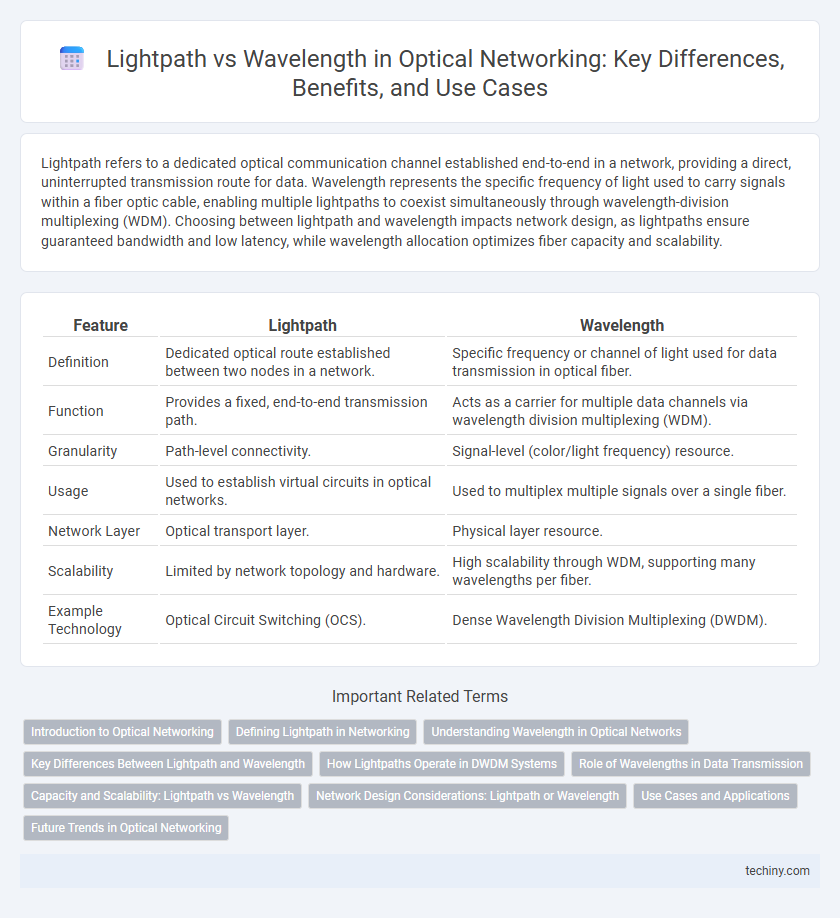Lightpath refers to a dedicated optical communication channel established end-to-end in a network, providing a direct, uninterrupted transmission route for data. Wavelength represents the specific frequency of light used to carry signals within a fiber optic cable, enabling multiple lightpaths to coexist simultaneously through wavelength-division multiplexing (WDM). Choosing between lightpath and wavelength impacts network design, as lightpaths ensure guaranteed bandwidth and low latency, while wavelength allocation optimizes fiber capacity and scalability.
Table of Comparison
| Feature | Lightpath | Wavelength |
|---|---|---|
| Definition | Dedicated optical route established between two nodes in a network. | Specific frequency or channel of light used for data transmission in optical fiber. |
| Function | Provides a fixed, end-to-end transmission path. | Acts as a carrier for multiple data channels via wavelength division multiplexing (WDM). |
| Granularity | Path-level connectivity. | Signal-level (color/light frequency) resource. |
| Usage | Used to establish virtual circuits in optical networks. | Used to multiplex multiple signals over a single fiber. |
| Network Layer | Optical transport layer. | Physical layer resource. |
| Scalability | Limited by network topology and hardware. | High scalability through WDM, supporting many wavelengths per fiber. |
| Example Technology | Optical Circuit Switching (OCS). | Dense Wavelength Division Multiplexing (DWDM). |
Introduction to Optical Networking
Lightpath refers to a dedicated optical circuit established end-to-end across a network, enabling high-capacity data transmission without electronic conversion. Wavelength denotes a specific frequency channel within the optical spectrum used to multiplex multiple data streams over a single fiber using Wavelength Division Multiplexing (WDM) technology. Optical networking leverages both lightpaths and wavelengths to optimize bandwidth allocation and enhance network scalability and efficiency.
Defining Lightpath in Networking
A lightpath in networking refers to a dedicated optical communication channel established between two endpoints over a fiber optic network using a specific wavelength. It enables high-capacity, low-latency data transmission by reserving an unshared wavelength through an optical circuit-switched network. Lightpaths are fundamental components of wavelength-division multiplexing (WDM) systems, allowing efficient bandwidth allocation and end-to-end optical connectivity.
Understanding Wavelength in Optical Networks
Wavelength in optical networks refers to the specific frequency of light used to transmit data across fiber optic cables, enabling multiple signals to coexist without interference through wavelength-division multiplexing (WDM). Unlike a lightpath, which is an end-to-end optical connection established along a specific route, a wavelength represents the individual channel that carries data signals over the lightpath. Understanding wavelength allocation and management is crucial for optimizing network capacity, minimizing interference, and ensuring high-speed data transmission in modern optical communication systems.
Key Differences Between Lightpath and Wavelength
A lightpath refers to a dedicated optical communication path established between two network nodes, ensuring a continuous flow of data without intermediate conversion or electronic processing. In contrast, a wavelength represents a specific frequency or channel of light used within a fiber optic network to carry multiple lightpaths simultaneously via wavelength-division multiplexing (WDM). Key differences include the fact that a lightpath is an end-to-end connection or circuit, while a wavelength is a physical property of light utilized to multiplex several lightpaths over the same fiber infrastructure.
How Lightpaths Operate in DWDM Systems
Lightpaths in DWDM systems operate by establishing a dedicated optical channel using a specific wavelength, enabling point-to-point communication without electrical conversion. Each lightpath carries data over a unique wavelength across fiber, avoiding interference with other channels and maximizing bandwidth efficiency. This wavelength-division multiplexing technique allows simultaneous transmission of multiple lightpaths, enhancing network capacity and reducing latency in high-speed optical networks.
Role of Wavelengths in Data Transmission
Wavelengths serve as distinct channels within optical fibers, enabling simultaneous data transmission through wavelength-division multiplexing (WDM) techniques. A lightpath is established by assigning a specific wavelength to create an end-to-end optical channel, ensuring dedicated bandwidth for high-speed communication. Efficient management of wavelengths significantly enhances network capacity and minimizes interference in optical networking.
Capacity and Scalability: Lightpath vs Wavelength
Lightpath provides dedicated end-to-end optical connections, offering high capacity with minimal latency, ideal for scalable data transport over long distances. Wavelength multiplexing increases network capacity by allowing multiple wavelengths on a single fiber, enabling scalable bandwidth without additional physical fibers. Lightpaths optimize capacity for specific traffic demands, while wavelengths maximize fiber utilization, enhancing overall network scalability.
Network Design Considerations: Lightpath or Wavelength
In network design, choosing between lightpath and wavelength allocation involves evaluating traffic demands and optical layer transparency. Lightpaths offer dedicated end-to-end channels for high-capacity, latency-sensitive applications, while wavelength assignment enhances network flexibility and efficient spectrum utilization. Optimizing this balance impacts scalability, fault tolerance, and overall network performance by minimizing wavelength conversion and reducing signal degradation.
Use Cases and Applications
Lightpaths provide dedicated, end-to-end optical connections ideal for high-capacity, low-latency applications like data center interconnects and disaster recovery networks. Wavelength division multiplexing (WDM) enables multiple wavelengths to share a fiber simultaneously, optimizing bandwidth utilization in metropolitan and long-haul networks. Enterprises and service providers use lightpaths for guaranteed performance and wavelengths for scalable traffic management across diverse network scenarios.
Future Trends in Optical Networking
Lightpath technology enables dedicated end-to-end optical channels for high-capacity data transmission, while wavelength refers to the specific frequency of light used in WDM systems to multiplex multiple signals. Future trends in optical networking emphasize programmable photonic networks, integrating software-defined networking (SDN) to dynamically allocate wavelengths and lightpaths based on traffic demand. Advances in elastic optical networks and AI-driven network optimization further enhance flexibility, scalability, and energy efficiency in next-generation optical infrastructures.
Lightpath vs Wavelength Infographic

 techiny.com
techiny.com